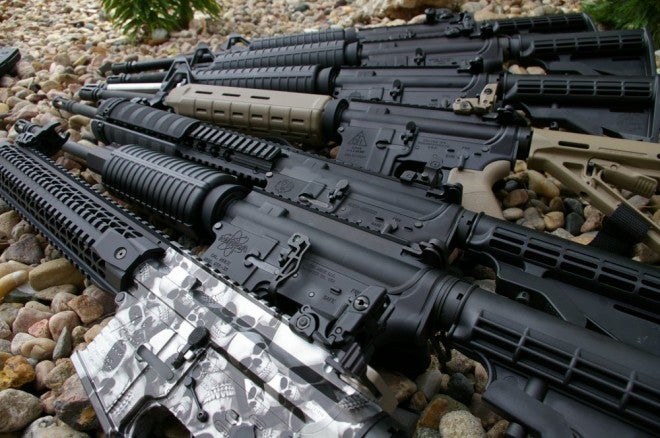Picking an AR-15 on a budget
Major Pandemic 07.01.13

The last few years — and the last six months, especially — have seen a flood of newcomers flock to the tried and tested AR-15 platform. If you’re one of those newcomers and you’re looking to buy your first or second AR, but for reasons of budget or sheer availability you either can’t afford or can’t find the $2,300 rifle of your dreams, then don’t despair. We’re here to help. There’s plenty of quality to be found in the budget AR space, and this guide will help you find it.
The beauty of the Eugene Stoner design is that even the “value line” parts of an inexpensive AR-15 will function and rattle along just fine for the average citizen. That noted, the higher end AR-15 parts will net more reliability, more consistent and better accuracy, maybe look aesthetically a little better, fit a little tighter, and ultimately function for a longer time without problems.
Over the last two years, I have tested and reviewed well over twenty AR-15s at range of price and quality points, and they all worked great. The guns I’ve hung on to just keep running and running. Some of those AR-15s include Smith and Wesson, Delton, DPMS, Spikes Tactical, Black Rain Ordnance, Double Star, Ruger, Yankee Hill Machine, ASA, JP Rifles, Houlding Precision, Barnes Precision Machine, and more.
For this article, I do not feel compelled to list every brand ever tested or available, because we’re lucky that a large variety of quality AR-15 firearms are available. Almost every AR manufacturer uses all the same parts made by the same six to twelve OEM manufacturers; some domestic and some overseas. There are obviously various quality levels and finish levels, so that $650 AR-15 generally will have a lower quality and/or lower surface finish than a $1200, $1500, and $2500 AR-15.
Note also that I am skipping the “build from parts” and “separately purchased uppers and lowers pinned together” options and focusing on complete, manufacturer-assembled rifles. In either of these build vs buy scenarios, you might be able to piece together a better buy or one which fits your wants closer than just buying a complete rifle, but in the majority of cases a complete rifle is the best bargain and is backed 100% by a warranty.
Choosing a caliber
Your choice of caliber really comes down to your intended purpose and how much you plan on shooting. It may also come down to whether you will be able to get any ammo for the caliber selected. For your first AR, you’re going to want to go with 5.56 Nato if you can get it.
The majority of AR-15s are chambered in 5.56 Nato or .223 Remington, which for all practical purposes are the same ammo. The 5.56 Nato is a smidge longer, and slightly more powerful, so any 5.56-chambered gun will safely shoot .223. The reverse, however, is not necessarily true. Almost every manufacturer will say their .223 Remington chamber will also shoot 5.56 Nato round safely, but you should always check to make sure. Many times 5.56 Nato surplus rounds can be found at a lower price, and it is good to have a flexible gun that can safely shoot either cartridge in the same barrel.
The .223 Wylde is an in-between chambering which will safely shoot either cartridge and is considered more accurate for match shooters — this is my prefered AR-15 chambering for target and match rifles. I prefer a 5.56 Nato chamber for more high reliability rifles.
The AR-15 can also be had in a number of other calibers, including the 300 Blackout, 7.62×39 AK 47 round, and even a .50 Caliber Beowolf round. But if you’re looking to buy your first AR-15, I would stick with the basics of a 5.56 Nato- or .223-chambered AR-15.
Barrel length and gas system
For AR beginners, I recommend a 16″ or 20″ barrel with a mid-length gas system. Now, while “barrel length” is an obvious parameter, it’s not clear at first what “gas system length” is. In short, the AR is cycled when the gases released by firing the gun blow back from the barrel into the chamber via a small tube port and tube placed atop the barrel. The length of this tube — pistol-, carbine-, mid-, or rifle-length — determines how long the gases take to travel back into the chamber and how much force the gun is cycled with.
Unless you are going to upgrade to an adjustable gas block at some point on a carbine length gas system, I am a huge fan of mid-length gas systems on 16″-20″ barrels and rifle-length gas systems on 20″+ barrels.
I have written articles on this for Syrac Ordnance which explains the intricacies, but in the end, mid-length and rifle-length gas systems deliver a softer shooting than a carbine-length gas system; plus, they give you a lot more real-estate for your support hand. This is why my recommendation for a first AR-15 would be a 16″ mid-length gas system. If all you can find is a carbine-length gas system, then don’t worry, as you can add an adjustable gas block on to soften the recoil impulse just like the 3-gunners do.